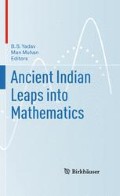Abstract
Besides using several mathematical formulas regarding permutations, combinations, geometric progression, and binomial coefficients, Ācārya Piṅgala applied binary codes to discuss the listing of even meters. Piṅgala’s Chandas Śāstram, the science of meters is the oldest authoritative work on Vedic and Sanskrit prosody. According to recent research, Piṅgala lived in the twenty-ninth century b.c.e. The purpose of this article is to discuss his binary system, the conversion of a binary number into its decimal equivalent and vice versa. A superfast method, due to Piṅgala, regarding the conversion of a binary number into its decimal equivalent is not available in modern textbooks of computer science.
Shyam Lal Singh has been a professor of mathematics and principal of the College of Sciences and Engineering in Gurukula Kangri Vishwavidyalaya, Hardwar, India. His areas of interest include fixed point theory and Vedic mathematics.
Access this chapter
Tax calculation will be finalised at checkout
Purchases are for personal use only
References
Eves, Howard Whitely: An Introduction to the History of Mathematics, Holt, Rinehart and Winston, 1976.
Kak, Subhash: Yamātārājabhānasalagam, An Interesting Combinatoric Sūtra, Indian J. History Sci. 35, 123–127 (2000).
Kedāranātha, Paṇḍita and Śarmā Vāsudeva (eds.): Chandas Śāstraṃ by Śrī Piṅgal̄ācārya with the Commentary Mṛitasañjīvani by Śrī Halāyudha Bhaṭṭa, Chaukhambha Publishers, Varanasi, 2nd Edition (Sanskrit), 2002.
Mīmānsaka, Pt. Yudhisthira: Vaidic Chandomīmānsā, Śrī Ramlal Kapur Trust, Sonipat, 1979.
Patwardhan, K. S., Naimpally, S. A. and Singh, S. L.: The Līlāvatī of Bhāskarācārya: A Treatise of Mathematics of Vedic Tradition. Motilal Banarsidass, Delhi, 2001, reprinted 2006.
Sarma, Rajeswara Sreeramula: Śūnya in Piṅgala’s Chandaḥsūtra, pp. 126–136 in: A. K. Bag and J. R. Sarma (eds.), The Concept of Śūnya, Indira Gandhi National Centre for the Arts, New Delhi, and Indian National Science Academy, New Delhi, 2003.
Upādhyāya, Baladeva: Sanskrit Śāstron Kā Itihāsa, Sharda Mandir, Varanasi, 1983.
Pearce, Ian G.: Indian Mathematics, Redressing the Balance, 2002; http://www-history.mcs.st-andrews.ac.uk/history/Projects/Pearce/index.html
Author information
Authors and Affiliations
Corresponding author
Editor information
Editors and Affiliations
Rights and permissions
Copyright information
© 2009 Springer Science+Business Media, LLC
About this chapter
Cite this chapter
Singh, S.L. (2009). Piṅgala Binary Numbers. In: Yadav, B., Mohan, M. (eds) Ancient Indian Leaps into Mathematics. Birkhäuser, Boston, MA. https://doi.org/10.1007/978-0-8176-4695-0_8
Download citation
DOI: https://doi.org/10.1007/978-0-8176-4695-0_8
Published:
Publisher Name: Birkhäuser, Boston, MA
Print ISBN: 978-0-8176-4694-3
Online ISBN: 978-0-8176-4695-0
eBook Packages: Mathematics and StatisticsMathematics and Statistics (R0)

